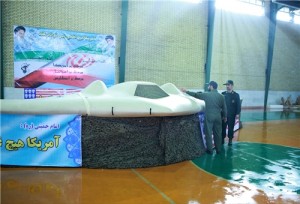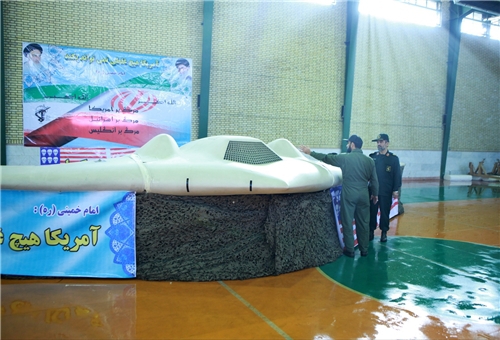 TEHRAN (FNA)- Lieutenant Commander of the Islamic Revolution Guards Corps (IRGC) said an Iranian drone which has been manufactured through the reverse engineering of the US drone which was tracked and hunted down in Iran late in 2011 will be unveiled to the public soon.
TEHRAN (FNA)- Lieutenant Commander of the Islamic Revolution Guards Corps (IRGC) said an Iranian drone which has been manufactured through the reverse engineering of the US drone which was tracked and hunted down in Iran late in 2011 will be unveiled to the public soon."All the memories and computer systems of this plane have been decoded and some good news will be announced in the near future not just about the RQ-170 and the optimizations that our forces have done on the reversed engineered model of this drone, but also in area of other important defense achievements," IRGC Lieutenant Commander General Hossein Salami said.
Iran announced on December 4, 2011 that its defense forces had downed a US RQ-170 aircraft through a sophisticated cyber attack. The drone was the first such loss by the US. US officials have described the loss of the aircraft in Iran as a setback and a fatal blow to the stealth drone program.
The RQ-170 has special coatings and a batwing shape designed to help it penetrate other nations' air defenses undetected. The existence of the aircraft, which is made by Lockheed Martin, has been known since 2009, when a model was photographed at the main US airfield in Kandahar, Afghanistan.
The unmanned surveillance plane lost by the United States in Iran was a stealth aircraft being used for secret missions by the CIA, US officials admitted almost a week after Iran captured the plane.
The aircraft is among the highly sensitive surveillance platform in the CIA's fleet that was shaped and designed to evade enemy defenses.
Since December, 2011, Iran has hunted down several more US drones of various types.
In January, a deputy commander of the Iranian Navy announced that the country's Army had hunted two more advanced RQ type Unmanned Aerial Vehicles (UAVs).
"The air-defense units of the Army have hunted two enemy drones," Deputy Commander of the Iranian Navy for Coordination Rear Admiral Amir Rastegari told FNA in January.
"These drones were from 11th series of the RQ class, and one of them was hunted in Shahrivar 1390 (August 21-September 19, 2011) and the other one in Aban (October 22-November 20, 2012)," Rastegari said, adding that the Army research center is now studying the two UAVs.
"Much of the data of these drones has been decoded by the Army's Jihad and Research Center," he said, but did not provide any further detail.
The remarks by the Iranian commander came almost one month after Iran announced on December 4, 2012 that the Islamic Revolution Guards Corps (IRGC) Navy had hunted a US UAV over the Persian Gulf after the drone violated the country's airspace.
 The IRGC navy commander announced at the time that the hunted UAV was a ScanEagle drone, adding that "such drones are usually launched from large warships".
The IRGC navy commander announced at the time that the hunted UAV was a ScanEagle drone, adding that "such drones are usually launched from large warships".ScanEagle is a small, low-cost, long-endurance unmanned aerial vehicle built by Insitu, a subsidiary of Boeing.
Iran later reproduced its own model of ScanEagle through reverse engineering techniques.
 In April this year, a senior Iranian parliamentary official announced that Iran has reverse engineered the RQ-170, adding that the Iranian version of the drone would soon have a test flight.
In April this year, a senior Iranian parliamentary official announced that Iran has reverse engineered the RQ-170, adding that the Iranian version of the drone would soon have a test flight."The brave personnel of the Armed Forces hunted down the drone with their knowledge and science and the Americans protested immediately and called for the return of the UAV," Chairman of the parliament's National Security and Foreign Policy Commission Alaeddin Boroujerdi said in the Northern city of Rasht in April.
Iran has downed several US drones so far and Boroujerdi did not mention which one he meant, but explained, "The reverse engineering started immediately (by the Iranian experts after hunting down the US UAV) and the Iranian type of the US drone will fly in Iran's Aerospace Organization soon which shows the Islamic Republic's might and power."
Boroujerdi's remarks referred to RQ-170. The drone has special coatings and a batwing shape designed to help it penetrate other nations' air defenses undetected. The existence of the aircraft, which is made by Lockheed Martin, has been known since 2009, when a model was photographed at the main US airfield in Kandahar, Afghanistan.
The unmanned surveillance plane lost by the United States in Iran was a stealth aircraft being used for secret missions by the CIA, US officials admitted in December. The aircraft is among the highly sensitive surveillance platform in the CIA's fleet that was shaped and designed to evade enemy defenses.
Iran has downed many other US drones as well, and they have always started reproducing them after conducting reverse engineering on them.
Iran has recently made giant advancements in aerospace industries, specially in designing and manufacturing pilotless drones.
In April, the Iranian Air Defense Force displayed its Sarir (Throne) drones on the occasion of the National Army Day.
Speaking to reporters at the time, Commander of Khatam ol-Anbia Air Defense Base Brigadier General Farzad Esmayeeli stated that Sarir is a long-range, long-endurance radar evading air defense drone.
"Sarir is capable of carrying cameras and air-to-air missiles and tens of this UAV have so far been produced and used," he added.
Also earlier this month, Iran displayed its most advanced UAV designed and manufactured by the country's engineers.
The stealth drone, named Hemaseh (Epic), was unveiled in a special ceremony in the presence of Defense Minister Brigadier General Ahmad Vahidi.
The ceremony was held on the sidelines of a conference to commemorate the defense ministry's martyrs.
Speaking to reporters on the sidelines of the ceremony, Vahidi stated that the drone has been built by defense industry experts and is capable of conducting surveillance and reconnaissance missions as well as combat missions simultaneously.
Earlier, Deputy Defense Minister for Industrial and Research Affairs Mohammad Eslami had told reporters that Hemaseh enjoys higher capabilities compared with other Iran-made UAVs and can fly at higher altitudes and enjoys longer flight endurance.











